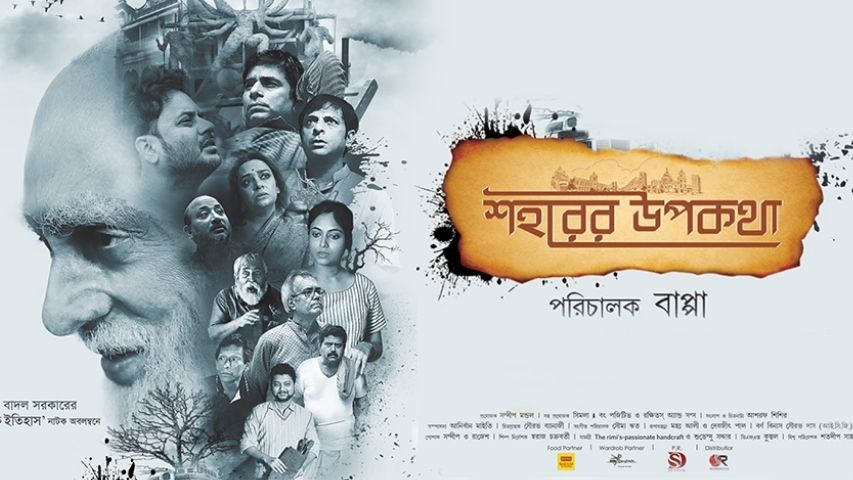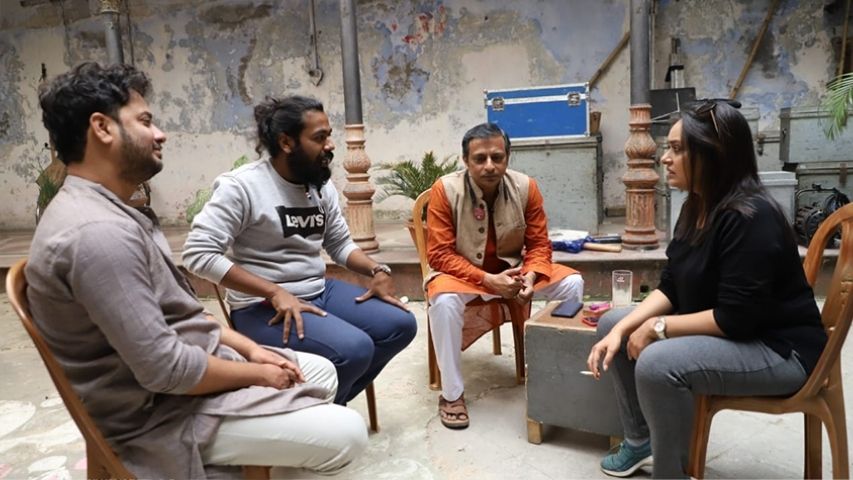-853X543.jpg)
The Forgotten History of Human Civilization
by Shantanu Ray Chaudhuri April 28 2022, 12:00 am Estimated Reading Time: 10 mins, 2 secsShantanu Ray Chaudhuri: A film based on a Badal Sircar play is rare. Rare still is a debutant filmmaker adapting one. That too in a moribund film industry. Which is what makes Bappa’s Sohorer Upokatha such a refreshing watch.
What is it that makes a debutant filmmaker opt for a Badal Sircar play written in 1965 as the subject for his film? Particularly in an industry notorious for playing it safe when it comes to literary adaptations restricted primarily to Byomkesh and Feluda or various works of Satyajit Ray who has become a cottage industry for a film fraternity that’s run out of ideas. It may have something to do with Bappa’s grounding in theatre.
The filmmaker says, ‘I completed my master’s in drama from Rabindra Bharati University, then became a theatre practitioner as a freelance artist, performing with many groups. In 2016, I thought that I would work on my own, and formed a theatre group named #ABongPositive. I directed several plays such as Achin Pakhi, Doshor, Baki Ek, Ishwar O Tumi, etc. I first read Baaki Itihaas around 2012 and found that what Badal Babu wrote about in 1965 was relevant even today - basically the history of human civilization as a history of death, destruction and exploitation. I became obsessed with adapting it to a film. Eventually, it was the seventeenth producer I contacted who agreed to give it a shot.’
A pioneering playwright, Badal Sircar invented the concept of street theatre in India and gave us what has come to be known as ‘Third Theatre’, which did away with the formal bindings of the proscenium stage and involved street plays where actors were attired no differently than the audience. Despite his stature as one of India’s most translated playwrights and as someone credited with ushering in modernism in Bengali theatre, Sircar’s work has never made it to the big screen, unlike those of many of his contemporaries like Vijay Tendulkar, Mohan Rakesh and Girish Karnad. Bappa’s Sohorer Upokatha, adapted from Sircar’s 1965 play Baaki Itihaas (Remaining History), written when he was in Nigeria, sets that anomaly right, and does so intelligently and creatively, in a manner that underlines the timelessness of this classic.
Baaki Itihaas encapsulates in itself thousands of years of human evolution through riots and wars, death and destruction to underline how mankind is still grappling with age-old ennui and exploitation. ‘This is what appealed to me about the play. The exploitation he spoke of in prehistoric times, in the Mahabharata or of slaves who built the pyramids in Egypt, continues even now - these are not spoken about; the thousands of children dying in Syria, the horrors perpetrated on women, these constitute the histories we do not document, the baaki itihaas, what remains,’ the director elaborates.
When a mutual acquaintance, Sitanath, commits suicide, a couple, Sharad and Basanti, create their own versions of what could have prompted Sitanath to take his life. These imaginings tell us as much about the narrators’ worlds as they do about the viewers.

In the version Basanti conjures, Kanak (Sitanath’s wife) hopes to build her own house on the plot of land she believes she owns. She bemoans the death of her father in a hospital fire and the fact that her sister, faced with pecuniary difficulties, was led ‘astray’. So, when she learns that Sitanath has mortgaged the land and spent the money in the bank too, she decides to leave him for his moneyed friend Nikhil. What she does not know, however, is that her father is alive and has been extorting money from Sitanath to keep the secret from Kanak, thus driving him to the edge of bankruptcy and to eventually taking his own life.
Sharad argues the premise that someone can willingly lose everything to preserve a lie, to keep pretenses alive, is somewhat dramatic, not quite in sync with the ordinary course of action a normal individual is likely to embark upon. Basanti retorts that there’s nothing normal or ordinary about death by suicide. Sharad comes up with his version in which Sitanath is a headmaster at a school. He has just rusticated a student for reading Nabokov’s Lolita, despite the school secretary Vidhu Babu’s pleading. Prodded by his friend Vijay, another version of the rich friend of Basanti’s, Sitanath’s wife Kanak tells him the story of the rape and murder of a young girl, Parvati, in the jungles of Chambalgarh when they were on vacation over a decade ago. The girl had a close relationship with Sitanath who, for some reason too unbearable to be articulated, holds himself responsible for her death. The incident has had such an impact on him that as Kanak tells Vijay, it marked the end of the conjugal relationship between the two. What makes it particularly difficult for Sitanath is the special relationship he has with Vidhu Babu’s granddaughter Gauri, who, like Parvati, idolizes Sitanath. In his state of turmoil Sitanath conflates Parvati with Gauri and even with Lolita, which in turn gives his overwrought reaction to a student reading Lolita a psychological edge.
In the play’s final act, Sharad and Sitanath come face-to-face in a surreal encounter, leading to the dramatic exchange where Sharad asks, ‘Why did you commit suicide, Sitanath?’ to which Sitanath responds, ‘Why didn’t you?’ What follows is an electrifying exchange between the two offering a scintillating snapshot of the decadence of human civilization.
Bappa’s adaptation, scripted by Ashraf Sishir, follows the original play faithfully, which is a good thing given the strength of Badal Sircar’s text that would be difficult to improve upon. There is of course the cosmetic change to the names of the characters: Sitanath is renamed Ritwick in the film, while Sharad becomes Mriganko, Basanti becomes Moumita and Kanak is christened Tanima in the film.
There are changes made in the service of cinematic representation, for example, beginning the narrative with a pre-credit prologue, which has Ritwick looking for Urmila in the jungles of Chambalgarh - a key plot point that comes late in the play’s second act. From these jungles the camera zooms out and then comes down to settle on the urban jungle that is the city of Kolkata.
The couple of major changes the screenplay makes enable the film to emerge from the limitations of the stage, providing a framing device, while contemporizing it to a post-pandemic world. The script introduces the character of Anindya as a struggling filmmaker. Post-credit, we see Anindya visiting a bookstore. An interesting exchange follows with the shopkeeper named Biplab (revolution), who spends his day watching pornographic videos on the net and who now discusses pornographic literature with Anindya. This leads Anindya to barter his copy of Lolita with a copy of Badal Sircar’s play. The link to Mriganko version of Ritwick suicide, which has the latter fuming about a school student reading Nabokov’s controversial novel is provided here.
We also learn that Biplab’s parents were involved with the Naxal movement, and his exchange with Anindya provides an insight into the failure of revolutionary thought in the country. As Anindya is increasingly fascinated with the text of Sircar’s play, he decides to adapt it to a film, which enables the filmmaker to frame the narrative and comment on the medium of cinema/art and its ability to make a difference.

The writers add contemporary events to the climactic exchange between Ritwick and Mriganko. Badal Sircar’s play drew upon the story of the Nishad woman and her children being burned to death in the Lakshagriha episode of the Mahabharata (the Pandavas knew of Duryodhan’s plan to set the house of fire but let the Nishad woman and her children die to camouflage their identity), the slaves who built the Colosseum in Rome and the pyramids in Egypt to call attention to historical exploitation of the weak by the strong. To that Bappa adds the death of migrant workers during the lockdown as they trudged back home, the rape and murder of eight-year-old Asifa in Kathua, Kevin Carter’s iconic 1993 photograph, ‘The Vulture and the Little Child’, in the New York Times, the razing of the Babri Masjid, the thousands of dead children in Syria to the litany of atrocities perpetrated on the weak and the marginalized. This is what Ritwick calls the ‘real’ history, the history that we conveniently forget. When Mriganko argues that this is a history of death, pat comes Ritwick rejoinder: is there life without death? Before he poses the question to which Mriganko has no answer: why are you still alive?
What is it that still makes us go on? Is there any purpose to life at all? Aren’t we all dead? Most people may not set themselves on fire or hang themselves, but haven’t they all stopped living? Aren’t all of them lugging around their ‘live’ corpses in a selfish search for pelf and power? The filmmaker underlines the mundane and culpability of contemporary middle-class existence, which is satisfied with vacuous candle-light vigils, social media posts and likes in the name of protesting injustice thereby assuaging guilt and comforting itself that it has done its duty.
In a startling bit of inventiveness, Bappa and his writer introduce Badal Sircar as a character in the film - Anindya meets the playwright to discuss the prospect of filming Baaki Itihaas. This device enables the filmmakers to have the playwright lament the failure of his work to usher in change. In the film’s final moments, when Anindya visits the bookseller again, he is no longer there. In keeping with the surreal exchange between Ritwick and Mriganko, it is Mriganko we see as the bookseller instead of Biplab. ‘Biplab has run away,’ Mriganko says, ‘The revolution is dead, long live the revolution’.
And Bappa reasons, ‘I think Badal Babu must have realized his failure to arouse social consciousness in the people. He did what he had to through his writing. Anindya is trying to do the same through his film - he admits that he is not capable of taking to the streets as a revolutionary. All he can do is to make a film. The revolution never materialized. From that thought comes the character named Biplab in the film, which goes missing in the end. People have learned to compromise. People no longer want revolution. We are too smug and secure in our petty lives to bother’.
The film comes full circle when Bappa, casting himself, comes across a copy of the play that Anindya leaves on a seat in a park next to the serenely flowing river. ‘In the last sequence I thought that the issues Baaki Itihaas deals with are somewhat like the Olympic flame passed on from one hand to another. Let the flame of revolution go from one hand to the other, just as the movie came to me from others who had possibly dreamed of making it but couldn’t - someone else might have another interpretation of the play. Even if we, as individuals, stop somewhere, the flame will continue. Let more filmmakers think of subjects like this.’
Amen to that. Held together by exceptionally strong performances – Joy Sengupta as Ritwick, Anindya Pulak Banerjee as Mriganko and Bidipta Chakraborty as Tanima deserve special mention, while Rahul Banerjee and Subhasish Mukherjee stand out as Anindya and Badal Sircar respectively, in well-written albeit brief roles.
Marked by intelligent writing, Sohoher Upokatha is that rare contemporary Bengali film that is mainstream in its writing and treatment and that engages without compromising on its artistic outlook.





-173X130.jpg)

-173X130.jpg)


-173X130.jpg)

-173X130.jpg)